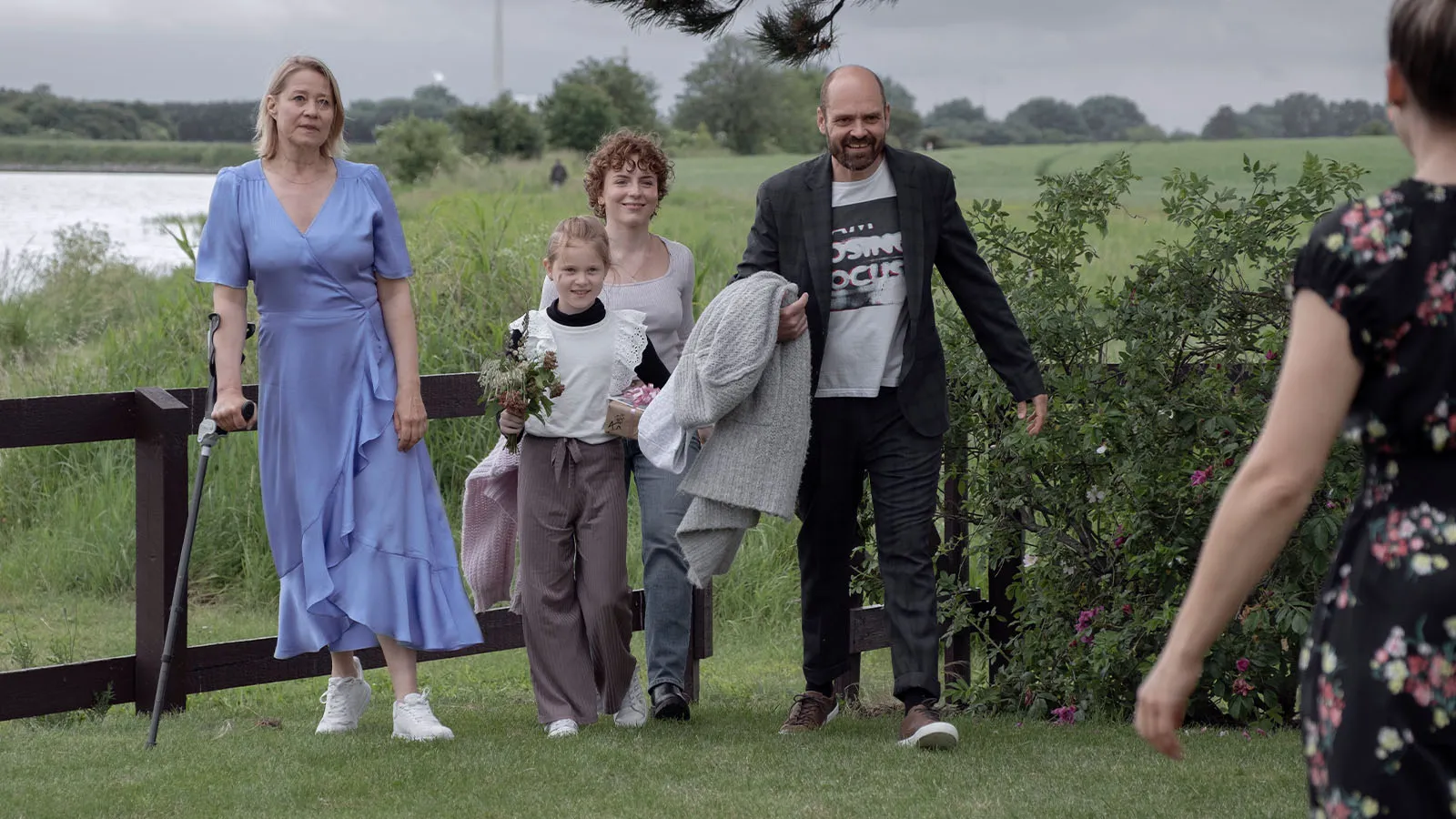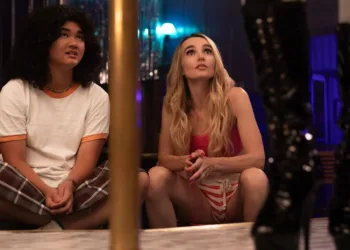Jeanette Nordahl’s Beginnings opens on the quiet tension of Ane and Thomas, a Danish couple who have long agreed to part ways but can’t yet tell their daughters. Ane is a high‑powered marine biologist juggling lectures and lab work; Thomas counsels troubled youth and carries the weight of a secret affair. Their teenage gymnast Clara and curious ten‑year‑old Marie orbit the family’s simmering unrest, unaware that a single morning will upend every plan.
What follows is a story about how life redirects us when control slips away. Ane’s sudden stroke freezes her career and marriage in mid‑air, forcing both parents to confront obligations they’d thought were behind them. Moments of tenderness—Ane’s first solo steps in a pool, Thomas’s careful brush of her hair—gain significance against a backdrop of ordinary rooms and muted northern light. Shot with a simple, observant eye, the film finds its power in the hush between words and the shifting weight of everyday gestures.
Establishing the Status Quo
The film opens in Ane and Thomas’s crowded kitchen, the clatter of groceries and half‑cleaned dishes underscoring years of shared routines. I’m reminded of early scenes in Kelly Reichardt’s Wendy and Lucy, where small details reveal character history—and here, a toy gymnast’s chalk in the flour speaks volumes. Ane is scooting between lecture notes and toddler toys, while Thomas checks messages from the youth center. These vignettes aren’t flashy, but they quietly expose the resentments simmering beneath polite smiles.
Rather than dramatizing Ane’s stroke, Nordahl holds the camera just outside the bathroom door. We hear a muffled thud and her lab coat hitting the tile; the unnerving soundscape—her lab equipment’s distant hum, then abrupt silence—becomes the narrative trigger. This choice echoes the off‑screen jolt in Aki Kaurismäki’s films, where what you don’t see amplifies the impact. Thomas’s return home carries guilt in every measured step; his eyes search the empty hallway before realizing their plans must change.
Ane’s rehabilitation unfolds through a series of sharp edits: a jump cut from her stabilizing in the pool to her collapsing in frustration, each stumble punctuated by echoing water drops. These rapid shifts mirror her internal chaos. Meanwhile, Thomas toggles between feeding Ane and texting Stine, his new girlfriend—a duality framed by split‑screen inserts that borrow from mainstream thrillers yet feel startlingly intimate here. Clara’s gymnastics routine, once smooth and controlled, fractures in jagged slow‑motion, highlighting how illness seeps into every corner of a family.
When Ane insists on walking unaided down a hospital corridor, the single, unbroken tracking shot captures her fierce desire to reclaim agency—and how physical limits remain ever‑present. Later, a tense supper scene reveals the divorce confession to Clara and Marie: close‑up reaction shots cut in rhythm with sporadic score notes, lending weight to each revelation. The final frame lingers on Ane’s hand reaching for Thomas’s—small, unresolved, yet charged with possibility.
Embodied Lives: Characters & Performances
Dyrholm commits fully to Ane’s physical constraints, inhabiting every stiff shoulder and labored breath. I couldn’t help recalling her raw turn in The Commune, but here she trades witty barbs for grim determination. When Ane flinches at a pool’s edge—hesitating before that first, punishing kick—it pulses with authenticity. In her breakdown at the dinner table, Dyrholm’s voice cracks like thin ice under weight, exposing a fury that feels grounded rather than staged.
Thomas is caught between obligation and escape, and Dencik maps that tension in a slight shift of gaze or the way he folds his hands. Early scenes show him kneeling to tie sport shoes, head bowed—so different from his upright, official posture at the youth center. Later, when he hesitates before helping Ane stand, you sense his own regret fighting through. It’s the quiet moments—his measured exhalations in the hallway—that speak loudest.
Storm’s screen debut surprises with its emotional precision. Her gymnast’s poise cracks in slow motion during a practice sequence, each wobble underscored by the film’s spare score. I’m reminded of Isabelle Huppert’s early work—stillness masking storm—and here Storm channels that adolescent fury when she finally confronts her father, tears and accusation interwoven in one blistering shot.
Marie watches from doorways and aquarium tanks, absorbing tension in wide‑eyed silence. Her intermittent care for her fish becomes a subtle metaphor: she tends fragile life even as her own world fractures. Though given fewer lines, those moments of quiet observance feel eloquent.
As Thomas’s new partner, Stine balances warmth and distance. Schmidt’s steady presence—her hands adjusting Ane’s pillow, her gentle questions—offers a mirror to Thomas’s guilt. While Stine could use more screen time, her few scenes anchor the film’s exploration of adult complicity.
Colleagues at the youth center and Ane’s lab mates appear in fleeting vignettes that amplify the couple’s unraveling. Their offhand comments—“How’s the research?” or “When’s the hearing?”—underscore how private crises ripple into public spheres, reminding us that no family drama unfolds in isolation.
Directorial Vision & Script Rhythm
Nordahl favors long, unbroken takes that let scenes breathe—whether it’s Ane’s labored first steps or the claustrophobic hush after her fall. By positioning the camera just outside the bathroom, she turns absence into atmosphere: the echo of a coat dropping becomes a shock in itself. Ambient sounds—the drip of a faucet, distant traffic—fill gaps in dialogue, inviting viewers to piece together what’s unsaid.
The screenplay, co‑written with Rasmus Birch, trades exposition for subtext. Exchanges between Ane and Thomas feel pared‑down yet loaded: a single line about a missed lecture carries as much weight as an extended monologue might. Scenes unfold at a measured pace, punctuated by sudden moments—Ane’s outburst at the dinner table or Clara’s fractured gym routine—that snap the narrative into sharper focus. Birch’s knack for simplicity reminds me of Andrea Arnold’s Fish Tank, where every word counts.
Tonally, the film holds emotion in check without sacrificing honesty. There’s genuine tension when Ane struggles to swim with one arm, but also flashes of wry humor—her deadpan reaction to a well‑meaning nurse’s pep talk made me smile. This blend of restraint and raw feeling keeps the drama grounded; it trusts audiences to feel the impact of small gestures rather than pushing for overt spectacle.
Visual & Auditory Texture
Shadi Chaban’s camera feels like a keen observer, shifting between tight, close‑quarters shots in the family’s kitchen and wider, sun‑drenched frames when Ane ventures outdoors. I found myself thinking of how Chaban’s work in a recent indie documentary captured similar private moments; here, interior frames feel almost claustrophobic, reflecting Ane’s limited mobility, while open skies in a lakeside rehab scene suggest a world she’s eager to rejoin. Subtle pops of warmer light—morning sun through curtains, the glow of a bedside lamp—remind us that hope can enter even the coldest spaces.
Rasmus Gitz‑Johansen’s editing stitches these visuals into a rhythm that echoes real life: there’s a quick montage of spilled cereal and running shoes, then a long pause as Ane tries to stand. The choice to cut from a bustling family meal to dead silence in a hospital corridor caught me off guard in the best way, as if the film lets its pulse slow whenever the story demands reflection. At moments, brief flashbacks flicker—Ane teaching at the university—sprinkling in context without derailing the main timeline.
Sound designer Nathan Larson layers everyday noises—hospitals beeping, dripping faucets, Clara’s chalk scraping the gym floor—so that silence itself feels charged. The score is built on sparse piano notes that surface during Ane’s therapy, never pushing too hard but offering just enough emotional lift. I was reminded of minimalist scores in Kelly Reichardt’s work, where music punctuates rather than overwhelms a scene’s natural sounds.
Production design turns the family home into a living diary. A perpetually cluttered kitchen counter, half‑emptied boxes of research models, and Marie’s aquarium full of tiny fish all serve as visual shorthand for lives in mid‑transition. The lab’s bright, sterile surfaces contrast sharply with the warm, lived‑in chaos at home, highlighting that Ane and Thomas occupy two very different worlds—even when they share the same roof.
Beneath the Surface: Themes & Symbolism
Ane’s physical recovery doubles as an emotional rebirth. Watching her relearn to walk reminded me of scenes in Krzysztof Kieślowski’s work, where small steps carry vast inner shifts. The film frames each milestone—first pool kick, first solo step—as milestones of personal reinvention, suggesting that every ending seeds a new beginning.
Here, love and duty lock arms. Thomas’s careful caregiving and Clara’s brittle outbursts reveal how trauma spreads through a household. Like watching my own relatives navigate a crisis, I saw how each family member becomes an emotional gauge, reflecting pressures and loyalties in ways words alone can’t express.
The stroke serves as a rupture between self and vessel. Nordahl emphasizes this through close‑up shots of Ane’s trembling hand and off‑balance posture, turning physical gestures into narrative milestones—each movement a chapter in her unfolding identity.
Water flows through the story: Ane’s marine research, her rehabilitation pool, and Marie’s home aquarium. Fluidity contrasts with the confining walls of their home, underlining how healing demands both resistance and surrender.
Final Reflections
Beginnings emerges as a quietly stirring portrayal of a family caught between duty and desire, carried by Dyrholm and Dencik’s fearless performances. Its measured pace and intimate close‑ups make each small interaction resonate, underscoring how unexpected upheavals force us to re‑examine our bonds and ourselves.
This is the kind of film that lingers long after the credits roll, inviting viewers to sit with its hushed truths. Fans of thoughtful art‑house cinema—and anyone who appreciates storytelling that values the spaces between words—will find in Beginnings a gentle yet affecting exploration of love, loss, and perseverance.
Full Credits
Director: Jeanette Nordahl
Writers: Rasmus Birch, Jeanette Nordahl
Producers: Eva Jakobsen, Mikkel Jersin, Katrin Pors
Executive Producers: Rikke Ennis, Trine Dyrholm
Cast: Trine Dyrholm, David Dencik, Johanne Louise Schmidt, Bjørk Storm, Luna Fuglsang Svelmøe
Director of Photography: Shadi Chabaan
Editor: Rasmus Gitz-Johansen
Composer: Nathan Larsson
The Review
Begyndelser
Beginnings turns an intimate family crisis into a moving exploration of resilience and renewal, anchored by Trine Dyrholm’s fearless portrayal and Nordahl’s keen, unhurried direction. Every small gesture—first steps in a pool, a shared glance—carries emotional weight, making this a quietly powerful examination of love tested by fate.
PROS
- Trine Dyrholm delivers a raw, compelling lead performance.
- Naturalistic direction that highlights small, meaningful gestures.
- Resonant themes of resilience and family obligation.
- Artful cinematography contrasts intimate interiors with open exteriors.
- Sound design and score subtly enhance emotional beats.
CONS
- Pacing may feel sluggish for viewers expecting high drama.
- Peripheral characters (e.g., Stine) are underdeveloped.
- Linear structure offers limited narrative surprises.
- Occasional tonal heaviness can border on somber.
















































